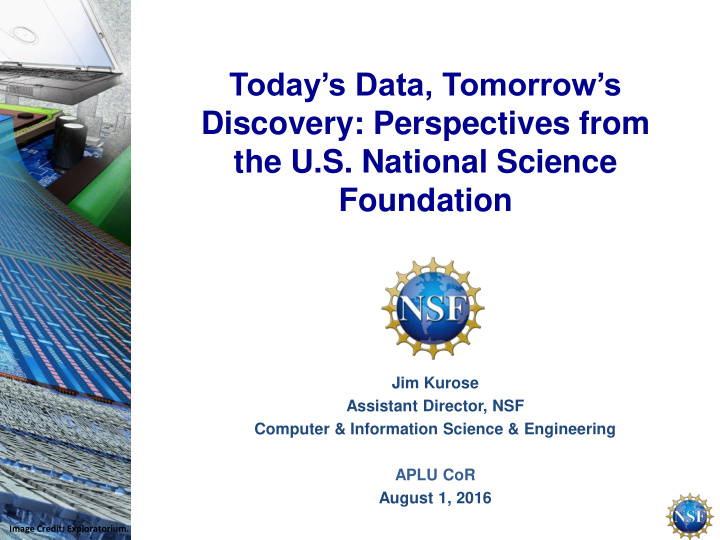



Today’s Data, Tomorrow’s Discovery: Perspectives from the U.S. National Science Foundation Jim Kurose Assistant Director, NSF Computer & Information Science & Engineering APLU CoR August 1, 2016 Image Credit: Exploratorium.
Overview NSF public access • a brief history • Publications • aata summary and future perspective
NSF Public Access clear and open communication of research results is central to the progress of science • publications • data [NSF] “continues its commitment to expand public access to the results of its funded research. Public access is intended to accelerate the dissemination of fundamental research results that will advance the frontiers of knowledge and help ensure the nation’s future prosperity” F. Cordova, Director, NSF, 3/18/15
NSF Public Access: a brief history 2013 2012 2014 2015 NSF Public OSTP Access Working memo Group US Office of Science and Technology Policy: directs federal agencies to develop plans to make publicly available to the “greatest extent and with the fewest constraints possible and consistent with law ” the “direct results of federally funded scientific research .”
NSF Public Access: a brief history 2015 2012 2013 2014 NSF Public Access NSF Public OSTP Plan published Access Working memo Group NSF ’ S PUBLIC ACCESS PLAN: Today ’ s Data, Tomorrow ’ s Discoveries Increasing Access to the Results of Research Funded by the National Science Foundation National Science Foundation March 18, 2015
NSF Public Access Publications: “ Investigators are expected to promptly prepare and submit for publication … all significant findings from work conducted under NSF grants .” Data: “ Investigators are expected to share with other researchers, at no more than incremental cost and within a reasonable time, the primary data, samples, physical collections and other supporting materials created or gathered in the course of work under NSF grants. ”
NSF Public Access Repository 2013 2012 2014 2015 NSF Public OSTP NSF Public Access NSF Public Access Access Working memo Plan published Repository online Group par.nsf.gov Provide public access to journal, juried conference papers Leverage existing systems, workflows: • Integrated with NSF-internal proposal, award management • Leverage DOE/OSTI infrastructure for publications; publisher/library services (e.g., CrossRef) • Extensible: other research products, federation PI’s must deposit publications in PAR, awards made FY 2016 onwards
PI, PO, and Public: Publisher data access to publications CrossRef DOI metadata NSF-Link (DoE) Best research.gov Log-in, NSF Available Input DOI (optional) link submit credentials Version NSF award, upload manuscript (DoE) manuscript PI publication data research.gov Log-in, NSF Create, edit, submit annual report; credentials auto-populate publications Ingest manuscript into PAR Project report Program eJacket Director eJacket jog-in manuscript View project reports, manuscripts par.nsf.gov research.gov Public Web Search, retrieve publications using keywords, metadata May 13, 2015 NSF Public Access Initiative 8
NSF Public Access Plan: data Data Management Plans: “data management is dynamic and practices vary substantially across the broad range of scientific disciplines supported by NSF” [NSF 15-52] “What constitutes reasonable data management and access will be determined by the community of interest through the process of peer review and program management. ” [Data Management & Sharing Frequently Asked Questions (FAQs)] bottom-up implementation in context of top-down guiding principles • “one size” does not fit all of science and engineering
NSF Public Access Plan: data Individual directorates providing updated DMP guidance DMP pilot projects funded (BIO, GEO, SBE) R&D funding for heterogeneous architectures, technologies for data-centric systems (DIBBS) Longer term: • continued consultation with multiple agencies • evolving DMPs as experience is gained, technology changes • roles, responsibilities, business models
Summary and Future Perspective Advancing Global Science by Public Access Policies NSF continues its deep commitment to expand public access to results of its funded research • NSF Public Access Plan: publications, data Realizing the enormous potential of Data requires a long-term, bold, sustainable, and comprehensive approach, by NSF and by our partners across the globe • Advancing science is truly a borderless enterprise
Recommend
More recommend